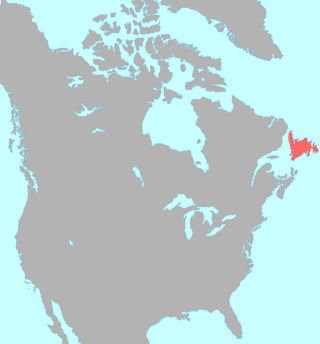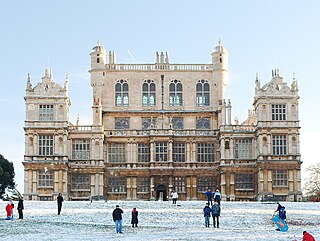
The Beothuk were a group of indigenous people who lived on the island of Newfoundland.

The Avalon Peninsula is a large peninsula that makes up the southeast portion of the island of Newfoundland. It is 9,220.61 square kilometres (3,560.10 sq mi) in size.

John Guy was an English merchant adventurer, colonist and politician who sat in the House of Commons from 1621 to 1624. He was the first proprietary governor of Newfoundland Colony, the first attempt to establish a colony on Newfoundland.

Captain John Mason (1586–1635) was an English sailor and colonist who was instrumental to the establishment of various settlements in colonial America. Born in 1586 at King's Lynn, Norfolk, and educated at Peterhouse, Cambridge. In 1610, he was appointed by James I to help reclaim the Hebrides. As a reward, he was granted exclusive fishing rights in the North Sea. This was ignored by the Dutch and he was treated as a pirate by the Scots. In 1615, he was arrested, but soon released after the seizure of his ship. He was appointed the second Proprietary Governor of Newfoundland's Cuper's Cove colony in 1615, succeeding John Guy. Mason arrived on the island in 1616 and explored much of the territory. He compiled a map of the island and wrote and published a short tract of his findings.

The Province of Avalon was the area around the English settlement of Ferryland in what is now Newfoundland and Labrador, Canada in the 17th century, which upon the success of the colony grew to include the land held by Sir William Vaughan and all the land that lay between Ferryland and Petty Harbour.

Sir Thomas Gates (fl.?–1622), was the governor of Jamestown, in the English colony of Virginia. His predecessor, George Percy, through inept leadership, was responsible for the lives lost during the period called the Starving Time. The English-born Gates arrived to find a few surviving starving colonists commanded by Percy, and assumed command. Gates ruled with deputy governor Sir Thomas Dale. Their controlled, strict methods helped the early colonies survive. Sir Thomas was knighted in 1596 by Robert Devereux, 2nd Earl of Essex for gallantry at the Capture of Cadiz. His knighthood was later royally confirmed by Queen Elizabeth I.

Boyd's Cove, also known as Boyd's Harbour, is a local service district and designated place in the Canadian province of Newfoundland and Labrador that is near Lewisporte. There is an interpretive centre dedicated to the earlier indigenous Beothuk settlement at this location.
Henry Crout was a settler and explorer, most likely from Devon in the English West Country. He became an investor in the London and Bristol Company and acted as Sir Percival Willoughby's agent and guardian to his son Thomas at the Cuper's Cove plantation in Newfoundland.

Sir Percival Willoughby of Wollaton Hall, Nottinghamshire was a prominent land owner, businessman, and entrepreneur involved during his lifetime variously in mining, iron smelting, and glass making enterprises in Nottinghamshire. He was also an important investor in the Newfoundland Company.
John Slany, Slaney or Slanie, etc., was an English merchant and ship builder of Shropshire origins who became Master of the Merchant Taylor's Company in 1620, and was the first and only Treasurer of the Newfoundland Company, chartered in 1610.
William Colston was an Englishman and one of the first settlers in the colony at Cuper's Cove, Newfoundland and Labrador, Canada.
Nicholas Guy was one of the first settlers at the London and Bristol Company's Cuper's Cove, colony in Newfoundland, and was the father of the first English child born in Newfoundland and subsequently all of the country of Canada.
Thomas Rowley, explorer and pioneer, born Shropshire, England, was one of the first settlers of John Guy's colony at Cuper's Cove, Conception Bay, Newfoundland, Canada. Rowley had accompanied John Guy on his expedition to Trinity Bay from Cuper's Cove in search of the Beothuk to make friendly relations with them for trade.
Thomas Willoughby colonist, born Wollaton, Nottingham, England was one of the first settlers in John Guy's colony at Cuper's Cove, Newfoundland, Canada. Willoughby is the third-eldest child of Bridget and Percival Willoughby.
Bartholomew Pearson yeoman, settler, born in Wollaton, Nottingham, England was one of the group of English settlers of John Guy's colony at Cuper's Cove, Newfoundland who had arrived in 1612, two years after the colony was established.

The New England Colonies of British America included Connecticut Colony, the Colony of Rhode Island and Providence Plantations, Massachusetts Bay Colony, Plymouth Colony, and the Province of New Hampshire, as well as a few smaller short-lived colonies. The New England colonies were part of the Thirteen Colonies and eventually became five of the six states in New England, with Plymouth Colony absorbed into Massachusetts and Maine separating from it. Captain John Smith's 1616 work A Description of New England first applied the term "New England" to the coastal lands from Long Island Sound to Newfoundland.

Newfoundland is a large island situated off the eastern coast of the North American mainland and the most populous part of the Canadian province of Newfoundland and Labrador. The island contains 29 percent of the province's land area. The island is separated from the Labrador Peninsula by the Strait of Belle Isle and from Cape Breton Island by the Cabot Strait. It blocks the mouth of the Saint Lawrence River, creating the Gulf of Saint Lawrence, the world's largest estuary. Newfoundland's nearest neighbour is the French overseas collectivity of Saint Pierre and Miquelon.

Newfoundland Colony was an English and, later, British colony established in 1610 on the island of Newfoundland off the Atlantic coast of Canada, in what is now the province of Newfoundland and Labrador. That followed decades of sporadic English settlement on the island, which was at first seasonal, rather than permanent. It was made a Crown colony in 1824 and a Dominion in 1907. Its economy collapsed during the Great Depression of the 1930s when the British Parliament passed the Newfoundland Act 1933, and on 16 February 1934, the British government appointed a six-member Commission of Government to govern the country. In 1949, the country voted to join Canada as the Province of Newfoundland.

Division No. 1, Subdivision G is an unorganized subdivision on the Avalon Peninsula in Newfoundland and Labrador, Canada. It is in Division 1 and contains the unincorporated communities of Baccalieu Island, Besom Cove, Bradley's Cove, Burnt Point, Caplin Cove, Daniel's Cove, Grates Cove, Gull Island, Job's Cove, Kingston, Long Beach, Lower Island Cove, Low Point, Northern Bay, Ochre Pit Cove, Red Head Cove, Riverhead, Smooth Cove and Western Bay.
Division No. 1, Subdivision I is an unorganized subdivision on the Avalon Peninsula in Newfoundland and Labrador, Canada. It is in Division 1 and contains the unincorporated community of Bristol's Hope.













